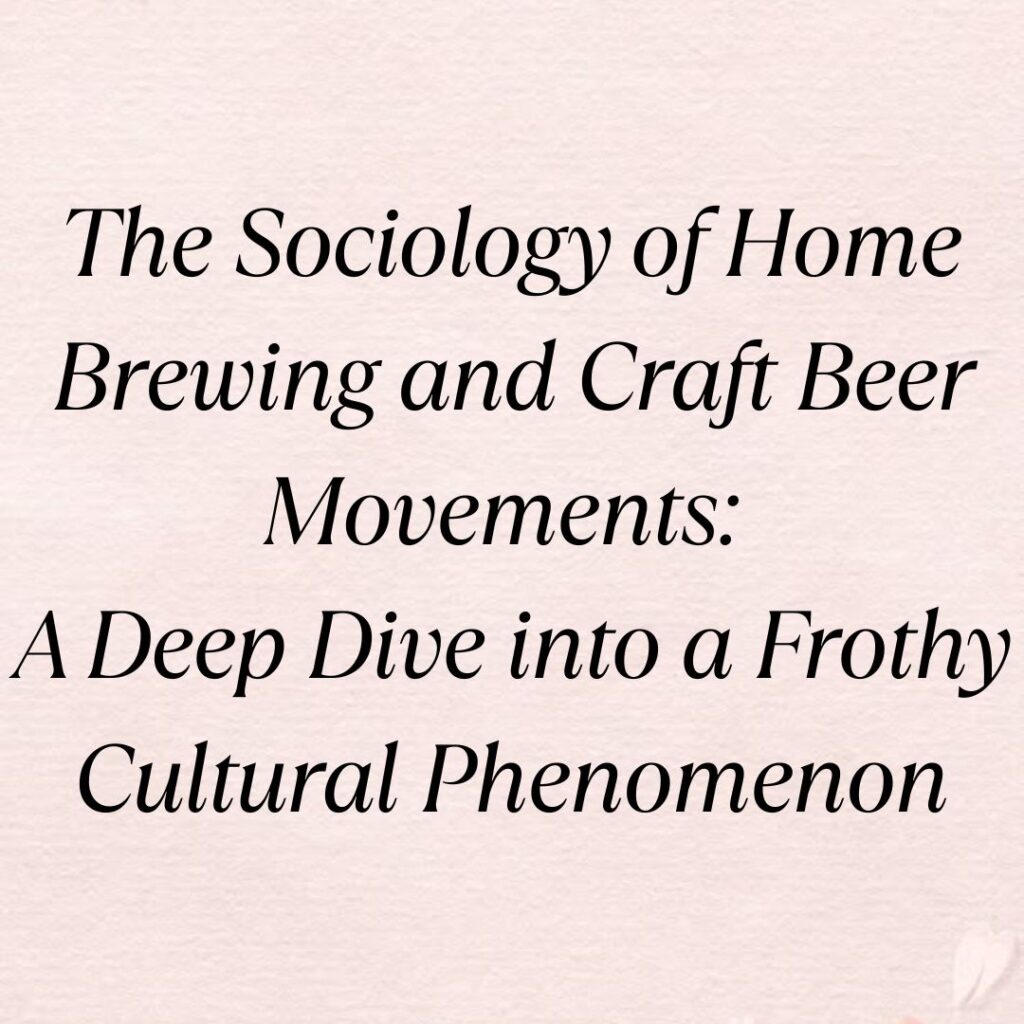Introduction
In the bubbling cauldron of modern culinary and cultural trends, few movements have gained as much traction and brewed as much excitement as the rise of home brewing and craft beer. Beyond mere hobbies or pastimes, these activities have evolved into robust cultural phenomena that intersect with economics, social dynamics, and even political landscapes. This article aims to explore the intricate web of sociology woven by the craft beer and home brewing movements, examining their roots, their societal impacts, and their future directions.
A Brief History of Brewing and Craft Beer
Brewing beer is as old as civilization itself. From ancient Sumerians to medieval monks, beer has been a staple of diets and economies worldwide. However, the Industrial Revolution marked a turning point. Mass production and standardization brought efficiency but diluted the artistry and diversity of beer. Enter the craft beer movement.
Craft brewing began as a grassroots reaction to the homogeneity of mass-produced beers in the late 20th century United States, spearheaded by pioneers like Fritz Maytag of Anchor Brewing and Jim Koch of Samuel Adams. These brewers championed traditional methods, quality ingredients, and innovative flavors, sparking a renaissance in beer appreciation.
The Rise of Home Brewing: From Hobbyists to Innovators
Simultaneously, home brewing saw a resurgence. Enabled by relaxed regulations and the availability of equipment and ingredients, enthusiasts began experimenting in kitchens, garages, and basements. What started as a way to replicate favorite brews evolved into a creative endeavor. Home brewers became pioneers, pushing boundaries with unconventional ingredients and techniques that later influenced commercial breweries.
For example, Garrett Oliver, brewmaster of Brooklyn Brewery, honed his skills as a home brewer before making significant contributions to the craft beer industry. This grassroots innovation is a hallmark of the movement, where hobbyists evolve into professionals, blurring the lines between amateur and expert.
Cultural Impact: Beer as a Reflection of Society
Beer has always been more than a beverage; it’s a social lubricant, a symbol of celebration and community. Craft beer’s emphasis on locality and authenticity mirrors broader cultural shifts towards sustainability and authenticity. Brewers like Sierra Nevada Brewing Company exemplify this ethos by sourcing ingredients locally and engaging with their communities.
Moreover, the craft beer scene fosters inclusivity and diversity. Women, minorities, and LGBTQ+ individuals have carved out spaces and voices in an industry traditionally dominated by white men. For instance, Kim Jordan co-founded New Belgium Brewing Company, a pioneering employee-owned craft brewery.
Economic and Political Dimensions
The craft beer boom has significant economic implications. It revitalizes neighborhoods, drawing tourists and investors to breweries and taprooms that double as community hubs. Cities like Portland, Oregon, and Asheville, North Carolina, have become craft beer meccas, showcasing the economic benefits of local brewing cultures.
Politically, craft brewers advocate for fairer regulations and market access, challenging the dominance of multinational conglomerates. Organizations like the Brewers Association lobby for independent breweries, promoting policies that support small businesses and consumer choice.
The Role of Technology and Social Media
Technology and social media have catalyzed the movement’s growth. Platforms like Untappd allow beer enthusiasts to rate and review brews, fostering virtual communities of connoisseurs. Breweries leverage social media for marketing and customer engagement, creating narratives around their brands that resonate with consumers.
Technological advancements also benefit home brewers, from precision brewing equipment to online forums where knowledge is freely exchanged. This democratization of information fuels innovation, empowering individuals to brew at professional standards in their homes.
Challenges and Future Directions
Despite its successes, the craft beer movement faces challenges. Saturation in the market and competition from big beer pose threats to smaller breweries. Economic pressures, like rising ingredient costs and tariffs, also impact profitability.
Looking forward, sustainability and diversity will likely shape the movement. Breweries are increasingly adopting eco-friendly practices, from water conservation to energy efficiency. Initiatives promoting diversity and inclusion aim to make the industry more reflective of society at large.
Conclusion: Beyond the Pint Glass
In conclusion, the sociology of home brewing and craft beer movements reflects broader societal shifts towards authenticity, community, and innovation. What began as a rebellion against industrialized beer has transformed into a global phenomenon that celebrates craftsmanship, locality, and inclusivity. As we raise our glasses to the future, it’s clear that beer, in all its forms, continues to be a powerful lens through which we view our culture and ourselves.
Whether you’re a seasoned brewmaster, an avid enthusiast, or simply someone curious about the frothy world of craft beer, there’s a pint-sized revolution brewing, and everyone’s invited to the taproom.
So here’s to the brewers, the drinkers, and the communities they create—cheers to the sociology of beer, where every sip tells a story and every pour brings us closer together.







